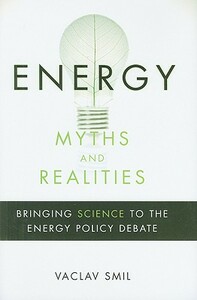You need to sign in or sign up before continuing.
Take a photo of a barcode or cover
10 reviews for:
Energy Myths and Realities: Bringing Science to the Energy Policy Debate
Vaclav Smil
10 reviews for:
Energy Myths and Realities: Bringing Science to the Energy Policy Debate
Vaclav Smil
This book is brutal, in a good way. It's just hard numbers on the viability of various renewable and non-renewable energy sources, and the US and global energy future. Short version:
All biofuels are a complete waste of time, at least with current fuel consumtion. We can generate electricity cheaply with renewables (this reader notes that onshore wind just dropped below natural gas, the former leader, for cheapest electricity generation cost), but using anything other than fossil fuels for things like the ICE and aircraft is just a non-starter.
-We'd have to cover the entire world in corn and stop eating it or growing anything else to have corn substitute for fossil
-Using biomass (crop leftovers, switchgrass, food waste products, human lipid tissue, etc) is even less viable. Not just at cost, but at scale.
-Solar and Wind: yep, these are acceptable ways to generate electricity, but of course do not answer the fuels question
The author is pretty ruthless, in an informative and well-supported way. He jokes about certain biofuels proponents breaking the laws of thermodynamics and physics to get to their results, and notes that some of these energy calculations are done in a vacuum and dont look at ancillary costs (e.g. transportation of biofuel source stocks from the ocean/farm/plastic surgery center to processing facilities).
A real eye-opener, close to 5 stars.
All biofuels are a complete waste of time, at least with current fuel consumtion. We can generate electricity cheaply with renewables (this reader notes that onshore wind just dropped below natural gas, the former leader, for cheapest electricity generation cost), but using anything other than fossil fuels for things like the ICE and aircraft is just a non-starter.
-We'd have to cover the entire world in corn and stop eating it or growing anything else to have corn substitute for fossil
-Using biomass (crop leftovers, switchgrass, food waste products, human lipid tissue, etc) is even less viable. Not just at cost, but at scale.
-Solar and Wind: yep, these are acceptable ways to generate electricity, but of course do not answer the fuels question
The author is pretty ruthless, in an informative and well-supported way. He jokes about certain biofuels proponents breaking the laws of thermodynamics and physics to get to their results, and notes that some of these energy calculations are done in a vacuum and dont look at ancillary costs (e.g. transportation of biofuel source stocks from the ocean/farm/plastic surgery center to processing facilities).
A real eye-opener, close to 5 stars.
Read for class.
This book makes a lot of important points about energy evangelists who want to sell solar power or wind, for example, as the Cure All to climate change. Smil points out the flaws in their arguments and explains why changes in energy sources are so hard to make.
However, sometimes Smil reads as overly pessimistic, almost shutting down any hope for a new energy revolution. It is clear from his conclusion that he does not think things such as nuclear power, etc. are useless (rather that they have been overhyped) but he sometimes reads that way throughout which made this a tough read for me. Additionally, Smil’s writing is extremely dry and scientific.
A good balance to Gates’ extreme optimism though!
This book makes a lot of important points about energy evangelists who want to sell solar power or wind, for example, as the Cure All to climate change. Smil points out the flaws in their arguments and explains why changes in energy sources are so hard to make.
However, sometimes Smil reads as overly pessimistic, almost shutting down any hope for a new energy revolution. It is clear from his conclusion that he does not think things such as nuclear power, etc. are useless (rather that they have been overhyped) but he sometimes reads that way throughout which made this a tough read for me. Additionally, Smil’s writing is extremely dry and scientific.
A good balance to Gates’ extreme optimism though!
Mostly solid critique on current energy options. I'm more 3.5 stars since Mr Smil dismisses the impact of climate change colors some of his findings.
informative
slow-paced
While I applaud the author's diligence in using data to prove his assertions, it came off more heavy handed and dense than I anticipated. Great information but reads like a textbook.
Written a little more than 10 years ago but it was still fun to read. The science & numbers don't really change with time so the observations still hold true.
Lays out the challenges with all the nonconventional/"renewable" energy and why it is impossible for them to dominate global energy production by 2050.
My takeaway from this is our best hope is probably nuclear power but the world leaders seems to have lost interest in it completely after disasters such as Chernobyl.
Lays out the challenges with all the nonconventional/"renewable" energy and why it is impossible for them to dominate global energy production by 2050.
My takeaway from this is our best hope is probably nuclear power but the world leaders seems to have lost interest in it completely after disasters such as Chernobyl.
Pinpoints with accuracy the complexity of energy policies in their real life application.
Decent but not particularly in-depth for anyone in the industry. Still worth a read and puts some facts into the discussion.
A very useful book. Read my analysis of it here: https://blog.hc3.io/engineering-and-entrepreneurship-opportunities-from-energy-myths-and-realities-by-vaclav-smil-facaf9728c31#.czmo9q1u5
A very useful book. Read my analysis of it here: https://blog.hc3.io/engineering-and-entrepreneurship-opportunities-from-energy-myths-and-realities-by-vaclav-smil-facaf9728c31#.czmo9q1u5


